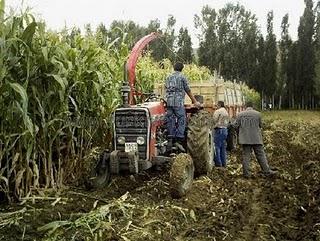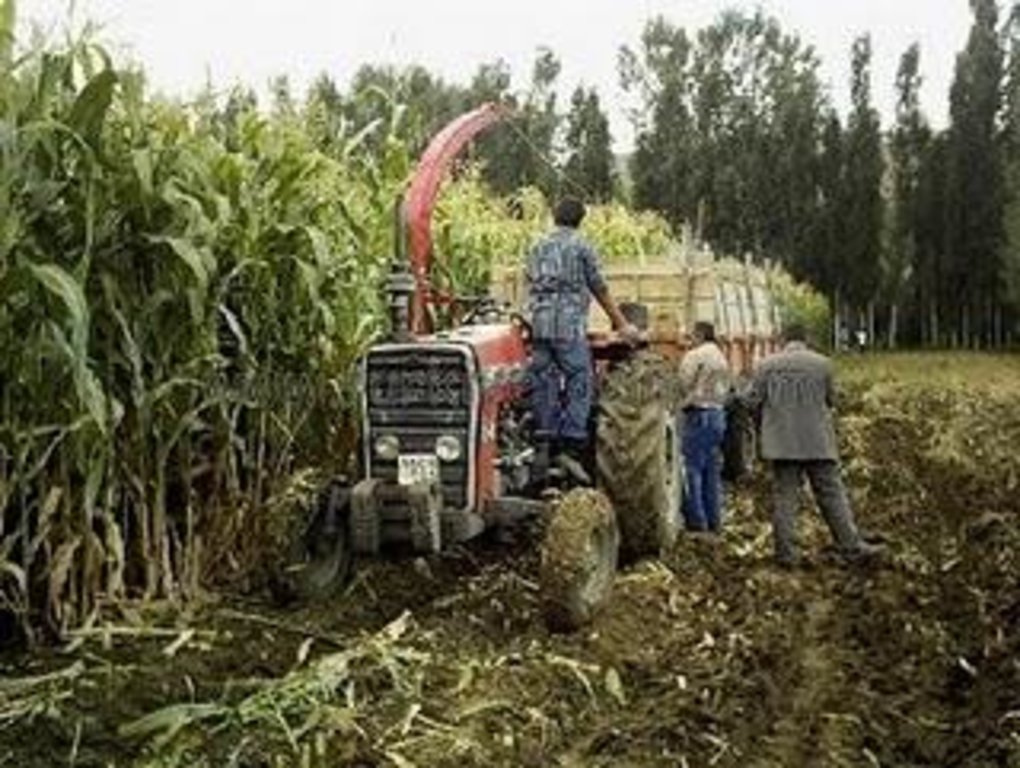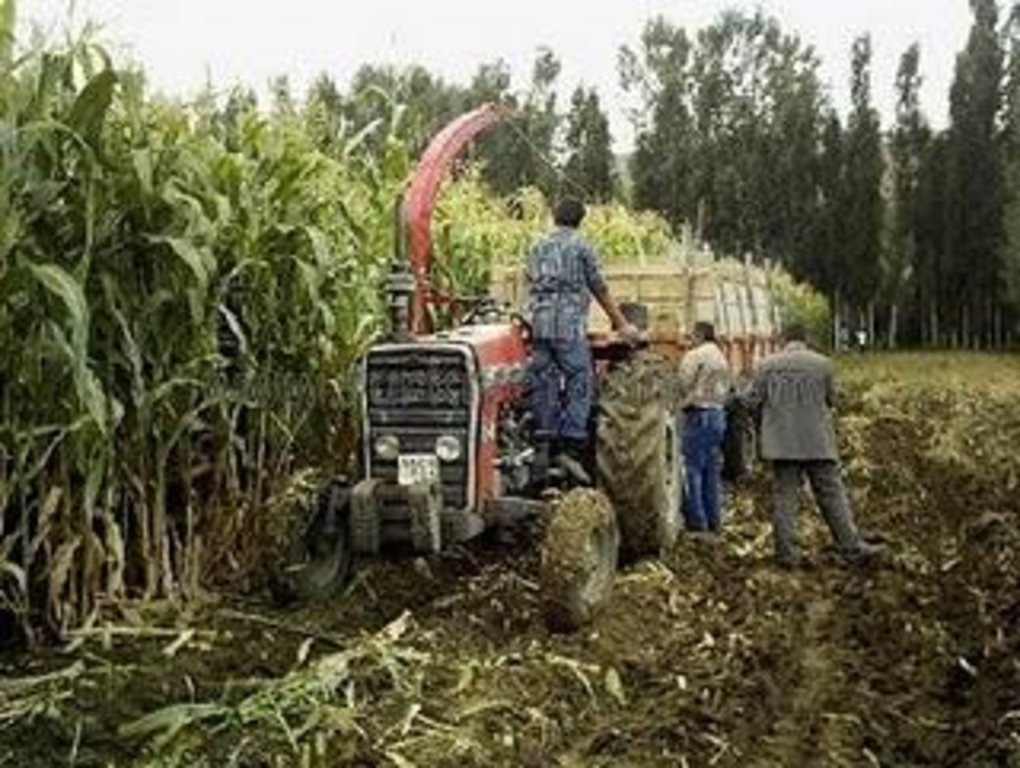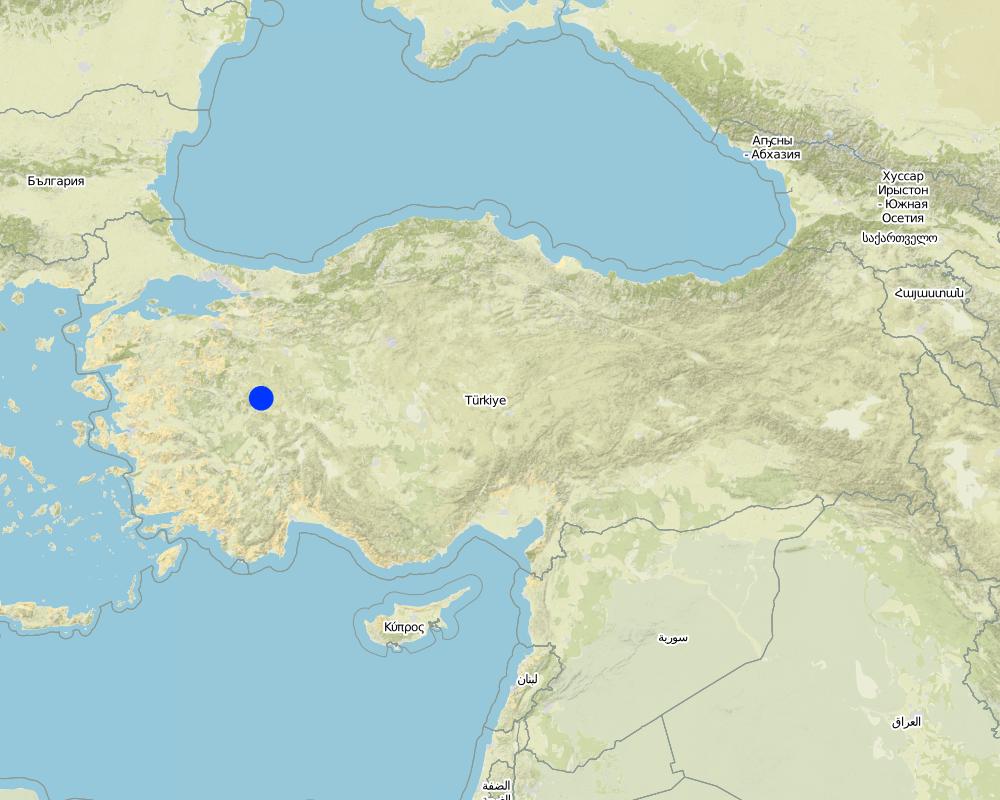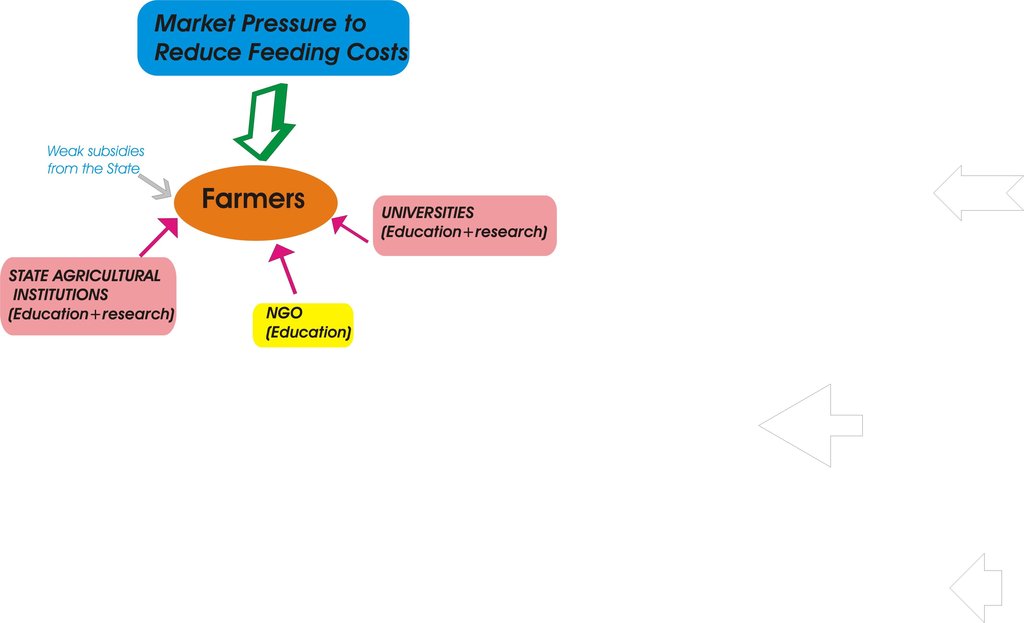Fodder Crops Production [土耳其]
- 创建:
- 更新:
- 编制者: Unknown User
- 编辑者: –
- 审查者: Fabian Ottiger
approaches_2425 - 土耳其
查看章节
全部展开 全部收起1. 一般信息
1.2 参与方法评估和文件编制的资源人员和机构的联系方式
关键资源人员
SLM专业人员:
Tolay Inci
土耳其
1.3 关于使用通过WOCAT记录的数据的条件
编制者和关键资源人员接受有关使用通过WOCAT记录数据的条件。:
是
1.4 SLM技术问卷的参考
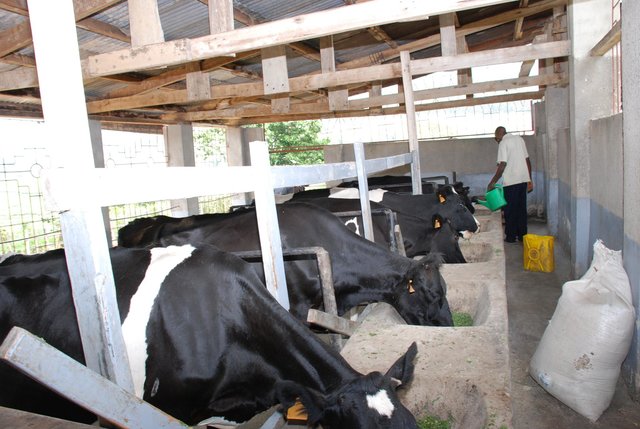
Dairy cattle fed with supplementary fodder [乌干达]
Elephant grass (Pennisteum purpureum) and calliandra (Calliandra calothyrsus), are harvested and chopped using a chaff cutter to produce fodder for dairy cows. The chaff is then mixed with cotton seed cake, molasses and maize bran to improve palatability and nutrient quality for dairy cows. The cattle graze in paddocks during …
- 编制者: Aine Amon
2. SLM方法的描述
2.1 该方法的简要说明
To grow different fodder crop species (leguminous and graminous) for feeding livestock
2.2 该方法的详细说明
该方法的详细说明:
Aims / objectives: It is aimed to grow livestocks feed for reduce costs of inputs in farms. Ease of feeding by this way is another motivation. Fodder crops especially leguminous ones are also very useful for improving and protecting soil fertility. Therefore farmers who produce both crops and livestock prefer to grow fodder crops.
Methods: Leguminous (alfaalfa, soinfoin, vetch) and graminous (corn for silage, barley, wheat, oat, triticale, rye) fodder species are grown in different growing seasons. Graminous fodder species are grown annually, among the leguminous species. Alfaalfa, sainfain are perennial and vetch is an annual species. The fodder species can be grown under dry conditions except corn. Leguminous species can not grow well if there is not enough rainfall; therefore they need irrigation. Application of the approach is mostly forced by market conditions where meat incomes were gradually decreasing in the last years due to macroeconomic policies. Training of the farmers is achieved by state institutions, universities and NGO's in a rather discontinous and sporadic way.
Stages of implementation: Soil tillage, fertilizing the soil, sowing the seeds, irrigation, harvest (1 for graminous species several times for leguminous species). Starting the approach by individual farmers is done by traditional communication and sometimes by training activities.
Role of stakeholders: All stages of the technology application are performed by participants. Technology is applied by farmers who have all the facilities needed for technology. They get some subsidizes from the state because of promoting the fodder crop production. State organisations, universities and NGO's provide irregular training courses and demonstrations. Rare scientific studies in terms of advantages of approcah are conducted by universities and state research institutes.
2.3 该方法的照片
2.5 采用该方法的国家/地区/地点
国家:
土耳其
区域/州/省:
Turkey
有关地点的进一步说明:
Keskin watershed, EskiÅŸehir
Map
×2.6 该方法的开始和终止日期
注明开始年份:
10
2.7 方法的类型
- 最近的本地倡议/创新
2.8 该方法的主要目的/目标
The Approach focused on SLM only
To reduce fodder input expenses by livestock producers.
The SLM Approach addressed the following problems: The problems to be addressed by the approach mainly arise from drought which increases recently. Because fodder crops production mainly relies on natural rainfall in the region. Also, lack of technical knowledge is another problem. Governmental unstability for subsiding fodder crops is also one of the problem for maintaining the approach.
2.9 推动或妨碍实施本办法所适用的技术的条件
社会/文化/宗教规范和价值观
- 阻碍
Education level of farmers is low and woman do not participate in performing approach.
Treatment through the SLM Approach: no solution yet.
财务资源和服务的可用性/可得性
- 阻碍
Input casts are high.
Treatment through the SLM Approach: Government partly subsidizes crop production.
法律框架(土地使用权、土地和水使用权)
- 阻碍
Some of land use rights are belong to a foundation, because of that some of farmers can not got subsidizes given by government.
Treatment through the SLM Approach: No solution yet.
了解SLM,获得技术支持
- 阻碍
Some growing techniques are not known well.
Treatment through the SLM Approach: Farmers get some help from governmental institutions. But most of them are aware of this.
3. 相关利益相关者的参与和角色
3.1 该方法涉及的利益相关者及其职责
- 当地土地使用者/当地社区
Because of cultural, educational and social reasons there are differences between the genders. Women are not well educated and much more interested in house works and children.
Both small and large scale farmers apply technology for its benefit.
3.2 当地土地使用者/当地社区参与该方法的不同阶段
| 当地土地使用者/当地社区的参与 | 指定参与人员并描述活动 | |
|---|---|---|
| 启动/动机 | 自我动员 | |
| 计划 | 自我动员 | |
| 实施 | 自我动员 | |
| 监测/评估 | 无 | |
| Research | 无 |
3.3 流程图(如可用)
3.4 有关SLM技术选择的决策
具体说明谁有权决定选择要实施的技术:
- 仅限土地使用者(自主)
解释:
Decisions on the method of implementing the SLM Technology were made by by land users* alone (self-initiative / bottom-up)
4. 技术支持、能力建设和知识管理
4.1 能力建设/培训
是否为土地使用者/其他利益相关者提供培训?:
是
明确受训人员:
- 土地使用者
4.3 机构强化(组织发展)
是否通过这种方法建立或加强了机构?:
- 是,少许
具体说明机构的强化或建立程度:
- 本地
具体说明支持类型:
- 财务
4.4 监测和评估
监测和评估是该方法的一部分吗?:
是
注释:
economic / production aspects were regular monitored by government, land users through measurements; indicators: amount of yield
area treated aspects were regular monitored by government through observations; indicators: for the subsidies
no. of land users involved aspects were ad hoc monitored by project staff through measurements; indicators: None
management of Approach aspects were None monitored by None through observations; indicators: None
There were few changes in the Approach as a result of monitoring and evaluation: Monitoring and evaluation activities have indirect and weak effect upon the approach since applicability of the approach is determined mostly by the demand of market.
There were few changes in the Technology as a result of monitoring and evaluation: Monitoring activities are mostly aimed to determine the subsidy payment but not to assess the efficacity of the technology. But the results of research projects is supposed to have a small impact upon the application of technology.
4.5 研究
研究是该方法的一部分吗?
是
提供进一步的细节,并指出是谁做的研究:
Research was carried out on-farm
5. 融资和外部物质支持
5.1 该方法中SLM组成部分的年度预算
如果不知道准确的年度预算,请给出一个范围:
- 10,000-100,000
注释(例如主要的资助来源/主要捐助者):
Approach costs were met by the following donors: government (as subsidies): 20.0%; local community / land user(s): 80.0%
5.2 为土地使用者提供财政/物质支援
土地使用者是否获得实施该技术的财政/物质支持?:
是
5.3 对特定投入的补贴(包括劳动力)
- 农业
| 具体说明哪些投入得到了补贴 | 程度如何 | 对补贴做出具体说明 |
|---|---|---|
| 种子 | 部分融资 | |
5.4 信用
是否根据SLM活动的方法给予信用值?:
否
6. 影响分析和结论性陈述
6.1 方法的影响
该方法是否帮助土地使用者实施和维护SLM技术?:
- 否
- 是,很少
- 是,中等
- 是,支持力度很大
Land users apply crop rotation when they use the approach. Leguminous fodder species provide nitrogen to the soil. It improves soil fertility so help sustainable land management.
该方法是否改善了阻碍SLM技术实施的土地使用权/用户权问题?:
- 否
- 是,很少
- 是,中等
- 是,支持力度很大
Did other land users / projects adopt the Approach?
- 否
- 是,很少
- 是,中等
- 是,支持力度很大
Did the Approach lead to improved livelihoods / human well-being?
- 否
- 是,很少
- 是,中等
- 是,支持力度很大
It moderately changed life quality by its ease in animal feeding and increase farm income.
6.2 土地使用者实施SLM的主要动机
- 增加生产
Using fodder crops allow farmers to feed their animals better and hence rise the quality of feeding.
- 增加利润(能力),提高成本效益比
approach basically diminish the cost of feeding and allow use of domestic (own) resources.
- 支付/补贴
Central government gives significant subsidies.
- 环境意识
Farmers know that the fodder crops enrich the texture and chemistry of soil.
6.3 方法活动的可持续性
土地使用者能否维持通过该方法实施的措施(无外部支持的情况下)?:
- 不确定
若否或不确定,请具体说明并予以注释:
Governmental supports (subsidies) help to continue the approach. If subsidies are not given, land users can not afford easily the approach. Additionally, if the pressure of market is higher they might totaly abandon animal feeding.
6.4 该方法的长处/优点
| 土地使用者眼中的长处/优势/机会 |
|---|
| It guarantees feeding their livestock. They are not affected from fluctuation in the price and presence of fodders in the market. (How to sustain/ enhance this strength: By technical help.) |
| It reduces input costs. (How to sustain/ enhance this strength: By financial support of government.) |
| 编制者或其他关键资源人员认为的长处/优势/机会 |
|---|
| It improves soil fertility. (How to sustain/ enhance this strength: informing farmers to use certain fodder crops such as leguminous fodders.) |
| It helps farmers to reduce inputs costs. (How to sustain/ enhance this strength: By continuous governmental support.) |
6.5 该方法的弱点/缺点以及克服它们的方法
| 土地使用者认为的弱点/缺点/风险 | 如何克服它们? |
|---|---|
| Livestock production is stricted by municipality due to internal regulations. | By loosing legal constrains. |
| Farmers are getting avoid to produce livestocks. | By governmal regulations. |
| 编制者或其他关键资源人员认为的弱点/缺点/风险 | 如何克服它们? |
|---|---|
| Drought greately effects yield | By increasing irrigation facilities, and hence state help. |
| It needs governmental support. | By stabilizing subsidies |
7. 参考和链接
7.1 方法/信息来源
- 实地考察、实地调查
- 与土地使用者的访谈
链接和模块
全部展开 全部收起链接

Dairy cattle fed with supplementary fodder [乌干达]
Elephant grass (Pennisteum purpureum) and calliandra (Calliandra calothyrsus), are harvested and chopped using a chaff cutter to produce fodder for dairy cows. The chaff is then mixed with cotton seed cake, molasses and maize bran to improve palatability and nutrient quality for dairy cows. The cattle graze in paddocks during …
- 编制者: Aine Amon
模块
无模块


